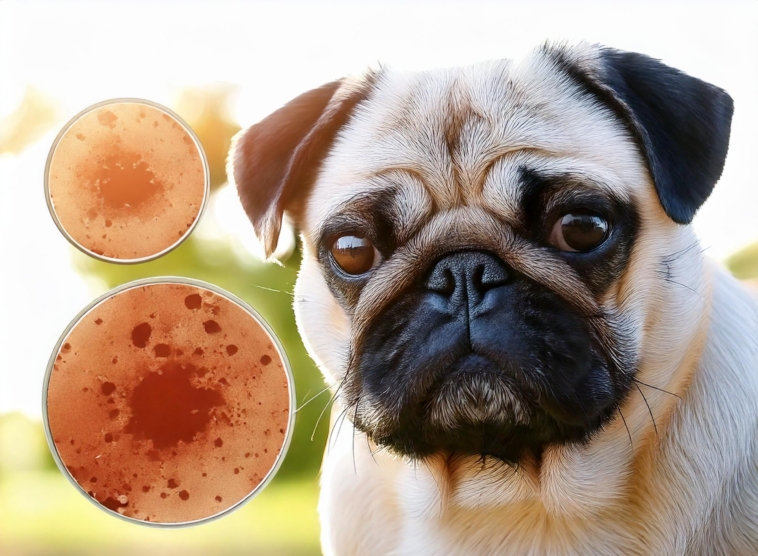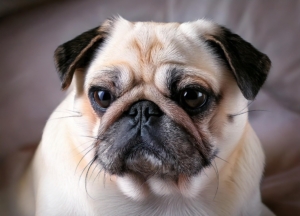Introduction: Pug Skin Problems – When Your Wrinkly Buddy Gets Itchy
Let’s face it—your adorable, squishy-faced pug might be cute enough to break the internet, but that same wrinkly charm comes with a side order of skin drama. Pugs are like furry little divas with delicate skincare needs. Miss a grooming session? You’re inviting a skin catastrophe.
From fiery rashes to full-blown “why-does-my-dog-smell-like-a-mildewed-sock” situations, pug skin issues are no laughing matter. But with some trips to the vet, TLC, and a well-developed sense of humor, your four-legged wrinkle-machine can live itch-free and fabulous
Common Pug Skin Issues (a.k.a. The Greatest Hits of Doggy Dermatology)
- Dermatitis: Essentially your pug having a tantrum on their coat—most often due to allergies.
- Pyoderma: Big word for infected pimples. Yes, your pug has acne. And no, don’t squeeze them.
- Yeast Infections: Wetness + pug skin folds = fungal party.
- Mange: Little parasites having a rave in your pug’s coat, causing hair loss and constant scratching
Weakness & Fatigue from Skin Issues: The Wrinkle Effect
If your pug’s skin is a battlefield, don’t expect them to be more “grumpy loaf of bread” and less “zoomie king.” Discomfort can play tricks on their joints, make them lethargic, and make your usually feisty snorter a floor potato.
Spot the Itch: How to Know Your Pug’s Skin is Acting Up
- Itching & Scratching: Ongoing scratching like they’re in flea debt.
- Dry, Flaky Skin: Pug dandruff—yep, it’s a thing.
- Hair Loss: Patchy coat = pug is losing the style war.
- Funky Smells: If your pug stinks like gym socks, it’s most likely a yeast infection.
- Sores & Scabs: Products of over-scratching like there’s something worth winning under their skin.
- Rashes: Small red flags waving “something’s up.”
Why Your Pug’s Skin is Throwing a Fit
Allergies:
- Environmental: Pollen, dust, mold—your pug’s arch-nemesis.
- Food: That fancy-schmancy kibble could be secretly treachery in a bowl.
- Contact: Shampoos, cleaners, or even grass can become skin villains.
Parasites:
- Fleas: The pesky little jumpers who enjoy nipping.
- Mites: Bring on the mange and epic pug drama.
- Ticks: The bloodsuckers no one asked for.
Infections:
- Bacterial & Fungal: Germs having way too much fun on your pug’s skin.
Genetic Drama:
- Seborrhea & Dermatitis: Passed down like a bad family memento.
The Skin Conditions Greatest Hits (Pug Edition)
-
Yeast Infection (Malassezia Dermatitis): When pug folds become a tropical rainforest.
-
Hot Spots: Basically skin on fire from nonstop biting and scratching.
-
Dandruff (Seborrheic Dermatitis): Tiny snowstorms of pug flakes.
How Vets Uncover the Mystery Behind the Itch
When your pug becomes an itchy enigma in a wrapping of folds, the vet may whip out the science equipment:
- Skin scrapings (a.k.a.: skin swabs for science)
- Allergy tests (similar to a pug take on “what made you sneeze?”)
- Biopsy (small skin clips to study the drama)
- Blood tests (because skin issues may begin on the inside)
Tackling the Itch Like a Pro (or a Pampered Celebrity)
Your doctor may prescribe:
- Medication: Antibiotics, antifungals, or steroids—the skin’s equivalent of a support group.
- Bathing: Frequent baths, particularly in those pesky creases (but no bubble beards, thank you).
- Clean Environment: Dust and dirt = drama. Keep things squeaky.
Home Remedies (When the Itch Isn’t Too Bossy)
For small gripes, get DIY spa:
- Oatmeal Baths: Pretty much a breakfast soak—but for scratchy skin.
- Aloe Vera: The cool gel from nature for when your pugs get too hot.
- Coconut Oil: Moisturizing per excellence… and for faking your pug’s on tropical holiday.
- Apple Cider Vinegar: Diluted splash rebalances the skin (don’t get in wounds or your pug’ll be screamin’).
The Pug Skin Diet: Feeding the Fluff Right
As a good Instagram influencer, your pug requires good skin nutrition:
- Proteins, Vitamins, and Minerals: Because wrinkle care isn’t free.
- Omega-3 & 6 Fatty Acids: The magic sauce for a shiny coat and reduced itching.
- Steer Clear of Junk: No corn, soy, or mystery meat—this is a pug, not a garbage compactor.
Sometimes a special diet is the true MVP in taming down the drama on your pug’s skin.
Final Thought: Wrinkles Are Cute—Until They Itch
Pug skin care isn’t about beauty—survival. From itch to stink, flakes to funk, your wrinkle-bug in chief requires diligent grooming, a spotless pad, a good diet, and a vet who won’t waver when taking a sniff at a pug.
Treat those folds like royalty, and your pug will treat you to love, snorts, and perhaps just a little less fur on the couch.





